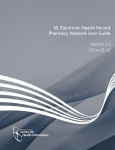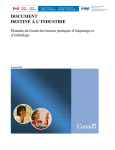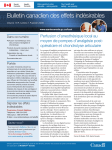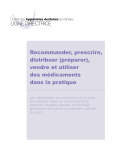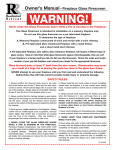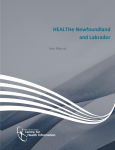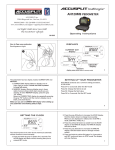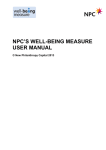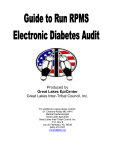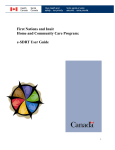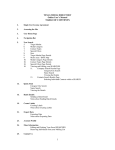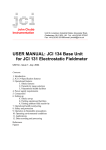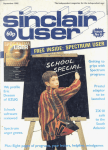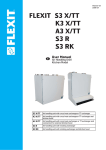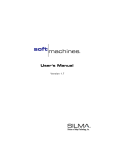Download NL Electronic Health Record Pharmacy Network User Guide
Transcript
NL Electronic Health Record Pharmacy Network User Guide Version 2.1 2015-06-01 Pharmacy Network User Guide v2.1 i Document Revision History Date 2012-02-08 2012-07-12 2014-03-26 2015-06-01 Version 1.01 1.02 2.0 2.1 Pharmacy Network User Guide v2.1 Status Description Draft Pharmacy Network User Guide revisions post DIS upgrade Draft Refresh and website links updated Approved Content and format update and alignment with Quality by Design Refresh and website links updated Author P. Gosse P. Gosse P. Gosse, E. Hamlyn P. Gosse ii Copyright Notice This document is fully copyright protected by the Newfoundland and Labrador Centre for Health Information Reproduction, in its original form, is permitted for background use for private study, education instruction and research provided appropriate credit is given to the Newfoundland and Labrador Centre for Health Information. Citation in editorial copy, for newsprint, radio and television is permitted. The material may not be reproduced for commercial use or profit, promotion, resale, or publication in whole or in part without written permission from the Newfoundland and Labrador Centre for Health Information. Pharmacy Network User Guide v2.1 iii PHARMACY NETWORK USER GUIDE TABLE OF CONTENTS Newfoundland and Labrador Pharmacy Network .......................................... 1 Introduction .......................................................................................................................... 1 Provincial Electronic Health Record ............................................................... 3 Connecting to the Pharmacy Network ........................................................... 5 Site Visit Strategy for Pharmacy Network Connections ....................................................... 7 Consent and Privacy Management ................................................................. 7 How to Comply with Confidentiality Processes .................................................................... 8 Pharmacy Network Processes ........................................................................ 9 Client Registry ....................................................................................................................... 9 Processing an Adoption ...................................................................................................... 13 Provider Registry ................................................................................................................. 14 Out of Province Providers ................................................................................................... 15 Location Registry................................................................................................................. 15 Drug Information System (DIS) Requirements ................................................................... 16 “How To” Guide for Pharmacy Practices ...................................................... 16 Filling Prescriptions ............................................................................................................. 16 e-Therapeutics .................................................................................................................... 20 Prescription Status .............................................................................................................. 20 Drug Utilization Review (DUR) ............................................................................................ 21 Pick-up Message ................................................................................................................. 22 Vendor Support ........................................................................................... 24 General Responsibilities............................................................................... 24 Responsibilities of the NL Centre for Health Information ............................. 24 Responsibilities of the Registered Pharmacist in Charge .............................. 25 Data Quality ................................................................................................ 26 Pharmacy Network Reports ................................................................................................ 26 Troubleshooting .......................................................................................... 26 Vendor Technical Support (Tier 1) ...................................................................................... 26 Centre’s Service Desk Support (Tier 2): .............................................................................. 27 APPENDIX A – ‘Ask Your Vendor’ ................................................................. 30 Appendix B - Easy Access contacts ............................................................... 34 Pharmacy Network User Guide v2.1 iv NEWFOUNDLAND AND LABRADOR PHARMACY NETWORK Introduction This User Guide has been prepared to provide pharmacy staff with information needed to access and use the Newfoundland and Labrador Pharmacy Network (Pharmacy Network). The Pharmacy Network is fundamental to the province’s vision for an integrated electronic health record (EHR), which aims to improve health through the provision of quality health information for all residents of the province. An EHR provides individuals with a secure, private, lifetime record of their health information and care within the healthcare system. The provincial EHR, viewed through HEALTHe NL, will be available electronically to authorized NL providers anywhere, anytime, to support high quality care. The Pharmacy Network includes the information of individuals, both residents and non residents, who have presented to a connected Newfoundland and Labrador community pharmacy. It enables viewing of a patient's profile when providing pharmaceutical care. This profile includes the patient’s demographic information and the associated medication profile. It may include over-the-counter and natural health products, as well as clinical and allergy information from pharmacies connected to the drug information system (DIS). It is important to note that the Pharmacy Network is not connected to or communicating with the Newfoundland and Labrador Prescription Drug Program (NLPDP), nor does the Pharmacy Network contain financial information. The Pharmacy Network is used by community pharmacy staff to update demographic and administrative information (e.g. name, address), as well as to record and share medication information in the provincial DIS. This connection enables authorized health professionals to access medication profiles in an online, real-time environment facilitating: Effective decision-making regarding the potential of a new medication reacting or having a side effect when taken in combination with other medications; Improved patient safety with respect to known allergies; Faster and more informed decision making in emergency situations; and Improvements in the use of medications and compliance with drug therapies. A primary benefit gained through connection with the Pharmacy Network is enhanced patient safety via the drug utilization review (DUR) process. The DUR process evaluates potential drug interactions, the appropriate use of medications and provides direct access to information resources. Connection to the Pharmacy Network expands the scope of the DUR beyond the pharmacy’s local system to encompass all recorded Drug Identification Numbers (DINs) on the patient’s Pharmacy Network medication profile. Pharmacy Network User Guide v2.0 1 For more information about the Pharmacy Network please visit the Newfoundland and Labrador Centre for Health Information (Centre) website: http://www.nlchi.nl.ca/index.php/the-pharmacy-network. This document will be reviewed annually and revised as necessary to ensure currency and usefulness. Feedback from readers is welcomed and encouraged. Suggestions for future updates can be sent to: Pharmacy Network Program Centre for Health Information 70 O’Leary Avenue St. John’s, NL A1B 2C7 Bus: 1-877-752-6006 Email: [email protected] Pharmacy Network User Guide v2.1 2 PROVINCIAL ELECTRONIC HEALTH RECORD Newfoundland and Labrador (NL) has developed a solid foundation for the development, adoption and use of the NL electronic health record. An electronic health record facilitates the sharing of data across healthcare delivery organizations and across the province and encompasses multiple point of service (POS) applications. The Newfoundland and Labrador blueprint is aligned with Canada Health Infoway (Infoway) to create a pan-Canadian interoperable electronic health record. Client Registry - provides unique identification of clients (individuals who have received health care within NL). The data provided is a consolidation of information collected from pharmacies that communicate with the provincial Client Registry through their local vendor systems (i.e., Kroll, Nexxsys, Assyst Rx, UBIK and Health Watch Next Generation (HWNG)), Regional Health Authorities through their Meditech systems, the Client and Referral Management System (CRMS), and the Department of Health and Community Services Medical Care Plan (MCP). The Client Registry is used to retrieve and validate accurate and complete client demographic and administrative information (e.g. name, address, and identification numbers). The Client Registry does not contain clinical information but enables clinical information to be linked to the correct individual within the EHR (e.g. DIS, patient chart). Provider Registry - provides unique identification of care providers. The Provider Registry is used to locate an authorized health care provider’s identification number (i.e. the provider’s license number) as well as their licensing information. Provider Registry data sources include: the Newfoundland and Labrador Pharmacy Board, the College of Physicians and Surgeons of Newfoundland and Labrador, the Newfoundland and Labrador Dental Board, the Association of Registered Nurses of Newfoundland and Labrador, and the Newfoundland and Labrador Optometric Board. Location Registry - provides unique identification of care delivery locations (e.g., pharmacies, clinics). Drug Information System - provides a complete summary of prescribed and dispensed drug information for clients. The DIS provides decision support capabilities by monitoring prescriptions against the client’s active medications and his/her personal profile. This may include over the counter medication, in some cases it may also store and provide a client’s allergy information. HEALTHe NL- a ‘view-only’ application that utilizes the Client Registry for client searching and provides authorized care providers access to clinical client information (i.e. DIS information) contained within the NL EHR. HEALTHe NL will evolve to include other relevant clinical information including lab results, diagnostic images and select clinical records pulled in from other eHealth systems. Pharmacy Network User Guide v2.1 3 Pharmacy Network User Guide v2.1 4 CONNECTING TO THE PHARMACY NETWORK New Pharmacy Network users must obtain a username and password, please refer to the Pharmacy Network Education site at http://www.nlchi.nl.ca/pharmacy/ Step 1: Read the Pharmacy Network education material and complete the online test. Access to a computer with an internet connection and printer is required when taking the test. If the Certificate of Completion is not printed at the time the online test is completed the online test must be retaken to reprint the Certificate of Completion. Review material found on the Pharmacy Network Education site; Receive a passing mark ≥ 70% on the test; and Print and sign the Certificate of Completion. Step 2: Complete, print and sign the appropriate Pharmacy Network Password Agreement. Enter the pharmacy name, mailing address, telephone number and email address; if no email address is available then a telephone number must be provided. This information will automatically print on the Password Agreement; Pharmacists are required to print and sign a copy of the online Password Agreement and have it witnessed by another licensed health care provider or a NL notary public; and Pharmacy assistants, technicians and students are required to print a copy of the online Password Agreement and have it signed by the pharmacist in charge of the location where they are working. o The pharmacist in charge must already be a registered user of the Pharmacy Network. o Pharmacy technician and student passwords are associated with a specific location; the pharmacist in charge must call the Centre to have an additional location added to, or removed from a pharmacy technician or student’s account. Note: If the Password Agreement is not completed and printed at the time the test is taken, it can be accessed later without having to retake the online test. In this circumstance, the Password Agreement would not be pre-populated and would need to be manually completed. Step 3: Fax the Certificate of Completion and the completed Password Agreement (Step 2) to the Centre at 1-877-272-6029. The Centre will process the application and contact the end-user to provide a Personal Identification Number (PIN) as well as further instructions on having the user account created; and Pharmacy Network User Guide v2.1 5 When the pharmacy is o connected to the Pharmacy Network applicants are contacted within 1-2 business days after the Centre receives this information; and o not connected to the Pharmacy Network applicants are contacted closer to the date of the store connection. Online education must be completed within four months of a pharmacy connecting to the Pharmacy Network. Step 4: To obtain a username and temporary password, contact the Centre’s Service Desk with the assigned PIN, and respond to the following three security questions: Questions are: 1. What is your favorite color? 2. In which city were you born? 3. What is your mother’s maiden name? The Centre’s Service Desk will provide the username and temporary password for accessing the Pharmacy Network. Step 5: Initial access to the Pharmacy Network requires the use of the provided temporary password. Once connected to the Pharmacy Network, the user is prompted to create a permanent password. o Password security features require a minimum of one uppercase letter, one lowercase letter, and one number and must be between 8-15 characters in length. o The password will expire every 6 months at which time the user will be prompted to create a new one. When you connect to the Pharmacy Network, you will begin to receive ‘Broadcast Messages’. Broadcast messages are a one-way communication from the Centre to provide Pharmacy Network end users with updates on system upgrades, new pharmacy connections, etc. Each vendor system displays these messages differently; please check with your vendor for more information. Vendor Education Additional training from the vendor is required to train pharmacy staff on new fields, screens and workflow changes in the local pharmacy system once connected to the Pharmacy Network; and A list of key questions to ask your vendor can be found in Appendix A. Pharmacy Network User Guide v2.1 6 Site Visit Strategy for Pharmacy Network Connections The Pharmacy Site Visit Strategy includes scheduled site visits (in-person and/or telephone) to identify any issues and to ensure end-user satisfaction. Visits occur during: Initial deployment (in-person); One month post deployment; Three months post deployment; Six months post deployment; Twelve months post deployment; Annual site visits; and Additional site visits (in-person or by telephone) may occur as needed. Site visits are collaborative and provide an opportunity to discuss questions or concerns pharmacy staff may have, as well as allow Pharmacy Network Program (PNP) staff to deliver educational updates and collect feedback from end users. For example, the pharmacy’s staff may request training on the process to register non-human specimens or office supply locations in their local vendor system. CONSENT AND PRIVACY MANAGEMENT The Provincial Health Information Act (PHIA) (http://www.health.gov.nl.ca/health/phia/phia_overview_june_2011.pdf) does not require consent for the collection of information in the Pharmacy Network and provides implied consent for use and disclosure of information related to the provision of health care. The Centre has provided custodians, such as pharmacists, who collect personal health information with brochures explaining disclosure of personal information to the Pharmacy Network. It is recommended that this information be displayed at the local pharmacy. A custodian is entitled to assume that they have an individual's continuing, ongoing implied consent to either use or disclose the information unless the custodian becomes aware that the individual has withdrawn his or her consent. Section 39(4) (c) of PHIA authorizes custodians such as pharmacists and other private practitioners to “disclose patients’ personal health information to or via an information network designated in the regulations under the Act without the consent of the data subjects”. The Pharmacy Network Regulations designate the Pharmacy Network as such an information network. As individuals are not able to opt out of having their information copied into the Pharmacy Network, the Centre has enabled individuals to restrict access to their information through consent directive functionality. Individuals are able to request that their profile be ‘masked’; in such cases, a password must be provided before health care providers are able to see the Pharmacy Network User Guide v2.1 7 masked profile. Brochures about masking a profile and the Pharmacy Network are available at connected pharmacies, and more information is on the next page. PHIA applies to all healthcare environments and establishes rules for collection, use and disclosure of patient health information whether it is paper or electronic. The Pharmacy Network as well as vendor functionality is built to be fully compliant with PHIA. Please refer to http://www.health.gov.nl.ca/health/phia/phia_overview_june_2011.pdf. How to Comply with Confidentiality Processes Patient Masking (Passwords) Patients have the right to limit the use or disclosure of their personal information by masking their Pharmacy Network profile. When a patient decides to mask their profile, the Pharmacy Network view is limited to local pharmacy content. Any patient profile data from other pharmacies will be masked to Pharmacy Network end-users, unless the password is provided. Unmasking occurs when the patient provides the password or in an emergency ‘break the glass’ situation. All demographic information is viewable on the Pharmacy Network. Patients requesting masking of their patient profile should be directed to the Centre’s Service Desk at 1-877-752-6006. For additional information, please refer to the Personal Health Information Act found within the Consent and Privacy Management section of this User Guide. Recognizing a Masked Patient Record Scenario Vendors can identify visual cues indicating when a patient record has been masked. Each local pharmacy system interface may be designed differently. Unmasking a Patient Record The Pharmacy Network supports unmasking when: A patient or his/her authorized representative provides the patient password to an authorized end-user; A patient requests that a Pharmacy Network administrator remove the mask on their information; and One-time temporary access to masked data is required (i.e. emergency ‘break the glass’ scenarios). The procedure for “breaking the glass” will vary by local pharmacy system. Professional judgment is to be used to determine whether a situation warrants this action. Pharmacy Network User Guide v2.1 8 Pharmacists should consult PHIA for information as to their responsibilities in a ‘break the glass’ situation. The patient should be notified if this occurs, and this action needs to be recorded on the patient’s profile. Patients have the right to ask the Centre for a report that reflects who has accessed their profile. When a Patient Refuses to Unmask their Record If a patient refuses to unmask his/her record, authorized end-users accessing the Pharmacy Network should utilize professional judgment governing adequate patient care. Storing a Patient Password While it is not necessary or appropriate to store patient passwords, passwords can be stored with the patient’s consent, as per the Personal Health Information Act. In this instance the password should be stored securely and treated as personal health information. Resetting a Patient Password To reset a lost or forgotten password, the patient must contact the Centre’s Service Desk (at 1-877-752-6006) and respond correctly to the security questions. PHARMACY NETWORK PROCESSES The Pharmacy Network utilizes patient information from the Client Registry, provider information from the Provider Registry, location information from the Location Registry, and clinical (prescription) information from the DIS and the local pharmacy vendor systems. Client Registry When a search is initiated on patient information in the Pharmacy Network, data is retrieved from the Client Registry. If a patient has never presented to the pharmacy you can retrieve information from this provincial database, saving time and effort. Pharmacy Network User Guide v2.1 9 Always search the Client Registry when you are syncing (synchronizing) new or existing patients in your local pharmacy system to the Client Registry. Search the Client Registry using ONLY the MCP number whenever possible. Sync each of your patients to the Client Registry on a one-time, go-forward basis when they present to the pharmacy. Verify and update patient contact information during each visit. When searching the Client Registry, the correct search order is: 1. MCP Card # only (e.g. 329123123123) it will return one record. a. Do not include additional data (such as name) in the search. 2. Client demographic information (e.g. name and date of birth) will return multiple records; choose with care. a. If the MCP number is not available, search using multiple patient demographic information (to distinguish the presenting ‘John Doe’ from multiple other ‘John Doe’ patients accessing healthcare within NL). b. When not using the MCP Card #, a multi-field search must be performed including: Name + date of birth + other options such as Gender (M - Male, F - Female) and/or postal code and/or phone number and/or street address and city. Choose with care as the search may return multiple records. The patient’s full legal name (first and last names), date of birth (DOB) and sex should align with the data on the MCP card. Validate patient’s DOB; if DOB discrepancies are identified, ask the patient to contact their third party insurer and/or MCP to correct this information. If no patient match is found or multiple match options are returned, request patient identification to confirm accuracy of the name, spelling and date of birth. Ask questions, confirm and update patient information. o What is your current address? What is your date of birth? Prompt the patient to determine if any of the following apply: o A nickname (Margaret vs. Peggy), middle name (James Dean vs. Dean James), multiple first names (Ann Marie) or alternative spelling of name (Jon vs. John, McDonald vs. MacDonald, Betty Ann vs. Betty-Ann); or any change to the last name (i.e. marriage or adoption). Name should match the patient’s MCP card; do not document nicknames (except as a note on the patient’s local file). DO NOT: Do not add nicknames or non-human specimens to the Client Registry (e.g., Lucky the dog, office supplies); and Pharmacy Network User Guide v2.1 10 Do not collect other data in the MCP field (e.g. policy #); this field is for MCP card # only. If the incorrect patient is selected from the returned list, the medications dispensed are linked to the wrong patient’s profile. Information displayed should always be confirmed with the patient to ensure it is accurate and updated as necessary. Duplicate or multiple records result in inaccurate medication profiles. The complete mailing address should be recorded in proper format, including the city, province, postal code and country: Canada Post has a free postal code search tool: www.canadapost.ca TIP: A patient’s driver’s license includes their address and postal code. Out of Province Patients When out-of-province patients or patients affiliated with Non-Insured Health Benefits for First Nations and Inuit (NIHB), or other health benefits programs require the services of a provincial pharmacy, ask whether they have ever: Lived in Newfoundland & Labrador? Received a MCP card? Previously received healthcare in the province? Presented to any NL hospital? Had a prescription filled in the province? If the answer to any of the above questions is ‘yes’, the patient should have an existing record within the Client Registry. If a search of the Client Registry has not returned a record, a new patient record needs to be added. Do not record other numbers (i.e. hospital cards) in the MCP field of your local pharmacy system. Do not add pets or office supply locations to the Client Registry. Contact the Centre’s Service Desk at 1-877-752-6006 if a duplicate or incorrect record is suspected on a valid search. Pharmacy Network User Guide v2.1 11 Synchronizing (Syncing) and the Client Registry Syncing occurs when a local patient record is linked to its match in the electronic health record. Pharmacy staff must sync existing patients to the Client Registry on a one-time, goforward basis. Do not sync a patient more than once. If you have a second local record for the same patient, merge it with the other local record (vendors can provide training on this process). The Pharmacy Network will reject transactions submitted with a pharmacy system local client identifier that has not been synced with the Client Registry. A prescription on the Pharmacy Network cannot be filled until the sync has been performed. Entering Patient Demographic Information Adding the MCP number will typically return a direct match and reduce data entry time. A minimum data set is required to successfully sync the patient record with the Client Registry. A prescription cannot be filled if these mandatory fields are missing: First and last name; Date of birth; Gender; Complete Address: First line, city, province, country and postal code; and Phone number. In order for the Pharmacy Network to perform as designed, it is important to send the postal code as part of the complete patient address. Failure to enter all of the above patient information can result in errors being received from the Pharmacy Network. Updating the Client Registry Pharmacy staff should verify demographic information (e.g. name, address, date of birth, telephone number) with the patient to ensure the information is up to date while ensuring the correct patient record is selected. Legal name, date of birth, gender and MCP number should match the information on the MCP card; and Pharmacy Network User Guide v2.1 12 Pharmacy staff should validate and make corrections to the address and telephone number at the patients’ request. For corrections to legal name (e.g., recently married), date of birth, and/or gender error direct the patient to call the MCP toll-free line: Avalon Region: 1-866-449-4459 Outside Avalon: 1-800-563-1557 Data elements collected by a pharmacy and subsequently sent to the Client Registry may be recorded only at the pharmacy and not exchanged within the Client Registry. E.g., MCP number will align with MCP source only because MCP is the source of truth for this data element. If a pharmacy records another identification key within the MCP field, it may be retained within the local pharmacy record only and not returned on a subsequent search. Processing an Adoption When an adoption takes place through the Department of Child, Youth and Family Services, PNP staff are notified if the client has a record in the Pharmacy Network. PNP staff will contact connected community pharmacies where an adoptee had a prescription filled so that local records can be acted upon appropriately. Communication will take place through phone calls as well as a secure transmission process. When contacted by PNP staff, pharmacies are expected to either: Inactivate the patient profile in the pharmacy’s local system and insert a local note indicating “Inactivated upon request of the Newfoundland and Labrador Centre for Health Information. Do not use this file as it may result in a patient confidentiality breach”. OR Place a note on the patient profile (if there are prescription refills) cautioning other pharmacy staff that utilizing this record may contribute to a confidentiality breach. Pharmacies are requested to: Create a new patient profile, ONLY if the patient presents to the pharmacy. Contact PNP staff if they suspect the pre-adoptive identity has replaced the postadoptive identity, or if there are any concerns regarding the adoptions record management process. PNP staff will include education and training related to adoptions record management in Pharmacy Network deployments and pharmacy follow-up visits, to ensure pharmacy staff are aware of the rationale and procedure. There may be situations where PNP staff work with community pharmacy staff on a case by case basis; no link should be made between the pre-adoptive and post-adoptive identities. Pharmacy Network User Guide v2.1 13 Pharmacy Network Program staff will forward, through registered mail or via secure managed file transfer (MFT), written documentation from the Centre stating the necessity of the actions associated with the pre-adoptive records. In the event that an adoption is disrupted, PNP staff will provide relevant demographic details regarding the adoption disruption, enabling the pharmacy to return information appropriately to the pre-adoptive identity. Phone calls will be utilized to follow up and ensure proper management of the records is completed. It is important to manage adoptions in a timely and specific manner; the above process will contribute to adoption management and support the future health care of the child/youth. The above process does not apply if an adoption takes place external to the Department of Child, Youth and Family Services. In that case, PNP staff are not notified and these adoptions are treated as an official name change only. Note: if PNP staff are notified, they will work with community pharmacy staff on a case by case basis; no link should be made between the pre-adoptive and post-adoptive identities. Provider Registry The Provider Registry is used by the Pharmacy Network to identify licensed health care providers in Newfoundland and Labrador. Registry data sources include: the Newfoundland and Labrador Pharmacy Board; the College of Physicians and Surgeons of Newfoundland and Labrador; the Newfoundland and Labrador Dental Board; the Association of Registered Nurses of Newfoundland and Labrador; and the Newfoundland and Labrador Optometric Board. The Provider Registry includes a unique ID (i.e., license number) for all authorized health care providers, their associated locations of practice, as well as their licensing information. The provider number is validated against the Provider Registry. If the prescriber license number results in a local pharmacy system error, pharmacy staff should call the Centre Service Desk to investigate. Vendors will demonstrate how to perform a search on the Provider Registry to obtain the license number. The provider license number is formatted differently when submitted for adjudication versus the Pharmacy Network purposes. The examples below highlight these differences: MEDICAL DOCTOR Pharmacy Network Adjudication 09876 P09876 (the letter P, F, R, L or M should already be populated by the vendor. New licensees may have to be added by the pharmacy staff) Pharmacy Network User Guide v2.1 14 PHARMACIST Pharmacy Network Adjudication NURSE PRACTITIONER Pharmacy Network Adjudication DENTIST Pharmacy Network Adjudication OPTOMETRIST Pharmacy Network Adjudication 67-142 67142 (remove the hyphen from DIS #) 14678 N94678 (remove first digit from DIS # and replace with N9) 018909XXX (there is no specific format for dentist license numbers) D88909 (remove first 2 DIS digits and add D8; then remove last 3 digits) NNNN (each ‘N’ represents a number from 1-9, i.e. 0602) TNNNNN (each ‘N’ represents a number from 1-9, i.e. T00602) If home healthcare items are written by a physiotherapist (for example), enter the items as “pharmacist prescribed” to place the item on the patient’s profile. If you do not find the provider: Insert an asterisk (*) before and after a word that is within the provider’s name, (i.e. *James*) to display any matches that contain the word ‘James’. Insert an asterisk (*) after the word, (i.e. Captain*) to display any location names that contain the first word of ‘Captain’. If the provider search is still unsuccessful, contact your pharmacy vendor system service desk for assistance. Out of Province Providers Out-of-province providers are recorded using 00000 for the Pharmacy Network. Out-of-province providers are recorded using P00000 for adjudication. P00000 is not a unique number. The use of this number is restricted to out of province providers only. Inappropriate, excessive or unnecessary use of this number can lead to data quality issues; therefore use of this value across the Pharmacy Network is monitored. Location Registry The Location Registry is used by the Pharmacy Network to locate an authorized health care provider’s identification number (i.e. the provider’s license number) and identify care delivery locations in NL (e.g. pharmacies and clinics). If you do not find the identification number: Pharmacy Network User Guide v2.1 15 Insert an asterisk (*) before and after a word that is within the provider’s name, (i.e. *James*) to display any matches that contain the word ‘James’. Insert an asterisk (*) after the word, (i.e. Captain*) to display any names that contain the first word of ‘Captain’. If the search is still unsuccessful, contact your pharmacy vendor system service desk for assistance. The address information for providers may not be their location of practice. If you cannot find a location within the Location Registry, call the Centre’s Service Desk at 1-877-7526006, requesting the addition of a specific location. Drug Information System (DIS) Requirements The Drug Information System functions as a data repository of person-specific prescribed and dispensed medications and includes information required for the Pharmacy Network. Each prescription should include: Drug name and dosage Prescriber Pharmacy (auto-populated) Pharmacist (auto-populated) Date dispensed Quantity dispensed Days' supply Instructions for use Indication for use – if available (optional field) Status of prescription order (pickup) – Mandatory Applicable clinical notes Quantity remaining Number of refills “HOW TO” GUIDE FOR PHARMACY PRACTICES Filling Prescriptions Each patient profile should be viewed when a prescription is filled. A patient’s profile can only be viewed for a clinical purpose. Allergies, medical conditions, and other information can be added to and viewed on the Pharmacy Network. All prescriptions, except those that are non-human (i.e., animals, office supplies) must be recorded in the Pharmacy Network. Vendors need to be consulted for their specific processes associated with filling prescriptions. Pharmacy Network User Guide v2.1 16 Pharmacies may at times process prescriptions when the patient is not present (e.g., prescription picked-up by a family member). When the patient file is created based on a prescription only: Query the Client Registry and accept Client Registry information if available, matching at minimum two of three key identifiers (i.e. MCP number, date of birth and/or name). Drug and Product Databases The Drug Product Database administered by Health Canada is available on each local pharmacy system. For a product or device that does not have a drug identification number from Health Canada’s Drug Product Database, please refer to the following databases: 1. Natural Health Products Database contains information about natural health products that have been issued a product license by Health Canada. Examples of products that would have a Natural Health Product Number (NPN) are Glucosamine Chondroitin, Ginkgo Biloba and Slow-K. The Natural Health Products Database is available via: http://webprod.hcsc.gc.ca/lnhpd-bdpsnh/index-eng.jsp 2. OPINIONS is a web-based database that assigns Product Identification Numbers (PINs) to products, which are usually devices that do not have DINs. Examples of products found in OPINIONS include diabetic test strips and insulin pump supplies. When recording these products pharmacy staff should identify the code as part of OPINIONS, prior to submitting to the Pharmacy Network. Products from the OPINIONS database can be used as ingredients in a compound. The OPINIONS database is available via: http://opinions.atlanticpharmaceutical.ca. The OPINIONS PINs are also listed in the Atlantic Pharmaceutical Services Inc. (APSI) 3. The Newfoundland and Labrador Pharmacy Network Product Identification Number (NLPN-PIN) list identifies ingredients and/or medical products that do not have a DIN, PIN or NPN. Examples of items contained in the NLPN PIN list are hydrocortisone powder, Tear Gel and wrist splints. A listing of NLPN PINs is available at http://www.nlchi.nl.ca/pinlist/. If the prescribed component is not identified on this list call the Centre’s Service Desk at 1-877-752-6006. Please note: Proper spelling of the component, the brand name, the label name and the drug form; and Pharmacy Network User Guide v2.1 17 Items added to the NLPN PIN list during this call to the Centre’s Service Desk will not be subject to DUR checks. Compound Prescriptions When pharmacy staff enters compound medications into the Pharmacy Network, at least one ingredient of the compound is required to have a drug Identification Number, OPINIONS Product Identification Number, Natural Health Product number or Newfoundland and Labrador Pharmacy Network Product Identification Number. Adding Non-Prescription Drugs to Patient Profiles If a patient asks to have a non-prescription medication recorded, the product is added to the patient’s Pharmacy Network profile based on the vendor’s process. The Pharmacy Network can accommodate the addition of non-prescription medications to the patient’s profile as an Other Medication (e.g. over-the-counter and natural health products). Examples of over-the-counter (OTC) items include diabetic and pump supplies, ostomy supplies, iron, vitamin C, Tylenol. Dispensing Over-the-Counter Codeine Preparations As per NLPB Standards of Practice, acetaminophen with codeine is recorded on the patient profile as a prescription with the pharmacist indicated as the prescriber. There are a small number of products containing narcotics that are sold over the counter such as Atasol 8 or cough syrup with codeine. When purchased, the pharmacist is required to record the item on the patient profile. Prescriptions for Third Party Billing Purposes If an item is being processed as a prescription only for third party adjudication purposes, the pharmacist should be recorded as the ‘prescriber’. For example, the pharmacist is identified as the prescriber when an occupational therapist provides the client with a toilet seat referral. Non Human (Veterinarian) Prescriptions The EHR should not include non human prescriptions (e.g., animals, office supplies). Veterinary prescriptions should never be sent to the Pharmacy Network. Ask your vendor for training on how to enter required information for a non- human specimen. No person should ever be intentionally flagged as an animal in order to exclude the and data quality issue. Pharmacy Network Guide record from theUser DIS; thisv2.1 practice would be a patient safety 18 Office-use Medications Office supplies (e.g., ward stock or medical bag supplies) are medications issued to a facility versus a specific patient. While the actual work flow for recording office supplies is vendor specific, here are some general steps: Select office supply, for the prescription; Choose the location to which the medications are being dispensed. If not found: o Insert an asterisk (*) before and after a word that is within the location’s name, (i.e. *Memorial*) to display any matches that contain the word ‘Memorial’. o Insert an asterisk (*) after the word, (i.e. Captain*) to display any location names that contain the first word of ‘Captain’. o If the location search is still unsuccessful, contact your pharmacy vendor system service desk for assistance. Enter all other applicable details; and Send the ‘office supply’ to the DIS. Non-human items (i.e. office supplies) should not be synchronized with the EHR (Client Registry). Erroneous Addition of Non-Human Records If non-human records are added in error, pharmacies may be contacted by PNP staff. When these types of clinical transactions are found and can be retracted, PNP staff will: Contact the pharmacy involved in a timely manner requesting they retract the prescribe and or dispense action; Request pharmacy staff mark the animal’s file as an ‘animal’ or set up a provider file for the ‘office supply location’ (not a patient file); and Educate the pharmacy staff involved on workflow processes associated with animals and/or office supply locations. When clinical transactions are found but cannot be retracted, they will remain on the Pharmacy Network but the animal and or office supply location can be deleted by PNP staff from the Client Registry. When no clinical transactions are found, PNP staff will: Contact the pharmacy, requesting the animal’s file be marked as an ‘animal’ or a provider file created for the ‘office supply location’ (not a patient file); and Pharmacy Network User Guide v2.1 19 Educate the pharmacy staff involved on workflow processes associated with animals and/or office supply locations. An animal or office supply location deleted from the CR cannot have further prescriptions sent to the Pharmacy Network by the original local pharmacy vendor system. A validation error will cause a hard stop ‘Retrieval of requested record failed: Error code: ‘EPERM.’ e-Therapeutics e-Therapeutics enables pharmacists and other practitioners to review various drugs, obtain warnings about possible interactions with other medications and herbal remedies, as well as view best treatment options for a wide variety of medical conditions. This includes Canadian drug names, advisories and alerts from Health Canada. Connected pharmacies have complimentary access to e-Therapeutics via: https://www.e-therapeutics.ca/ Note: the username and password are provided to pharmacies when they connect to the Pharmacy Network. Disclaimer: e-Therapeutics is managed and maintained by the Canadian Pharmacists Association (CPhA), not the Centre’s Service Desk. Any difficulty experienced when accessing the e-Therapeutics system, or searching for information can be directed to the Canadian Pharmacists Association at: CPhA Customer Service, available Monday to Friday from 8:30 a.m. to 4:30 p.m. EST at 1-800-917-9489 CPhA online Feedback form (accessible through their website) Email [email protected] Fax questions to 1-800-601-1904 Mail correspondence to: Canadian Pharmacists Association Attn: Product Management 1785 Alta Vista Drive Ottawa, ON K1G 3Y6 Prescription Status A prescription’s final status is “aborted” on the Pharmacy Network, with the following status changes being accepted: From “complete” to “aborted”; From “complete” to “suspended”; and From “suspended” back to “complete”. Pharmacy Network User Guide v2.1 20 For example, when an end user copies a prescription to create a new one, the old prescription is aborted on the Pharmacy Network. Dispenses are validated on the total quantity prescribed, versus validation on the number of refills. A prescription status will change to “complete” when the total quantity has been dispensed and picked up. “Copying new” to dispense a prescription with a remaining quantity is not required. If the total quantity prescribed is not sent when the original prescription is added to the Pharmacy Network, the validation will occur on the total day’s supply. During the dispense process, there is validation against the original prescription on the days’ supply only when the total quantity is not provided. Retract There are limitations associated with retracting prescriptions. Changes (or removals) required to a prescription or dispense that has been sent to the Pharmacy Network can be made (retracted) provided the record has not been viewed by an end-user at another location. Only the last event can be retracted (by authorized staff at that location), which means that if a prescription has been dispensed and picked up, only the pickup can be retracted. The “retract” functionality (removing a record such as a prescription or allergy from a patient’s Pharmacy Network profile) is not linked to a specific user within the same location. If a record cannot be removed from the Pharmacy Network (because it is not retractable): Put a note on the record for others users to see; and Abort the record. Note: When prescriptions are “logged” on file, and not dispensed, the user who “logged” the prescription will be required to “retract” the prescription. Drug Utilization Review Pharmacy Network DURs are activated at the time of dispense, checking against other current medications on the patient’s medication profile. DURs can be reviewed at anytime by a pharmacist, and other clinicians can view how a particular DUR was managed. Medications are not included in future DURs when: The days’ supply of a specific medication is complete, based on the actual date of pick up; and A medication is deactivated. Information on managing DURs can be recorded when the DURs are displayed to the user; the Pharmacy Network also allows recording information on DUR management at a later time. Check with your vendor as to what is allowed on the local pharmacy system for DUR management. Pharmacy Network User Guide v2.1 21 The Pharmacy Network DUR checks include: Controlled Substance Drug to Drug Drug to Gender Drug to Known Disease Drug to Lactation Drug to Pregnancy Duplicate Ingredient Duplicate Therapy/Switchback Min/Max Too Late Too Soon Drug to Allergy Note: Pharmacy technicians should always notify the pharmacist when a DUR notification is received from the Pharmacy Network. Drug Utilization Review on Masked Records The Pharmacy Network DUR includes information which has been masked. However, complete profiles are not made available unless the patient profile is unlocked using the patient password or in an emergency, i.e. ‘breaking the glass’. Pick-up Message The pick-up message is designed to identify when a patient pays for the prescribed medication; the pick-up message is what distinguishes patients that should be excluded from a DUR because they have finished a medication. Prescriptions are included in DURs for one year from the original prescribed date if a pick-up is not recorded. When the pick-up message is recorded, the Pharmacy Network will utilize the pick-up date and extend the duration of the DUR if the pick-up date is different than the dispense date. Recording the pick-up will aid in keeping DUR messages to a minimum. Not recording the pick-up means that the Pharmacy Network has not received updates associated with recorded prescriptions. Consequently, if a patient should come back for a refill, an alert DUR will display, reflecting that the previous prescription is waiting to be picked up. Reversals Pharmacy Network users should continue to perform reversals as per current pharmacy practice. Discontinuations To ensure completeness of the patient’s Pharmacy Network profile, prescriptions should be discontinued if a patient has stopped using the medication. Discontinued medications will not be included in the DUR. Queuing Pharmacy Network User Guide v2.1 22 If the Pharmacy Network is not available due to scheduled maintenance or unforeseen downtime, users will be notified via fax and/or email. Pharmacy Network users should continue to work off-line, entering prescriptions into the local pharmacy system until the issue is resolved and connectivity has been re-established. At that time, the local pharmacy system will submit accumulated data from the queue (the process is vendor specific). Note: Normal operations can continue with the exception of DUR checks from the Pharmacy Network. When the connection is re-established, Pharmacy Network users may need to check the local system queue and manage pending Pharmacy Network transactions (Client Registry duplicates, invalid providers, DURs to be managed against the entire patient profile, etc.). The notification of issues and the resolution will vary based on the workflow and pharmacy vendor system used. Ask your vendor for instructions on how to continue working when the Pharmacy Network is unavailable as well as how to reconnect and submit queued transactions when the Pharmacy Network has re-established connection. Transfers When performing a prescription transfer, Pharmacy Network users should adhere to the process outlined by the NLPB. When transferring a prescription out of your pharmacy, a transfer message is sent to the Pharmacy Network requiring the local pharmacy vendor system to specify the transfer location: http://www.nlchi.nl.ca/images/ELID_Listing_15.11.13.pdf This message will reassign ownership of the prescription and will allow the pharmacist at the receiving pharmacy to “download” the prescription to their local application and create a dispense against it. The prescription will stay active on the Pharmacy Network profile but will be deactivated on the sending pharmacy local patient profile. If you are transferring a prescription to another province, the “Out of Province” location should be selected. Adding Clinical Notes to the Pharmacy Network There is a difference between adding notes to a local pharmacy system (e.g. patient prefers snap cap vials) versus notes documented and shared via the Pharmacy Network. Ask your vendor for a demonstration; it is important to differentiate between local notes and notes that may be shared across a patient‘s electronic health record. Adding Patient Allergies to the Pharmacy Network Pharmacy Network User Guide v2.1 23 Patient allergies can be added to the Pharmacy Network by licensed providers and pharmacy technicians. Allergies may be transferred ‘to’ or ‘from’ the Pharmacy Network. Ask your vendor for a demonstration of this process. VENDOR SUPPORT Vendors make modifications as appropriate to communicate with the Pharmacy Network, and the Centre provides support to vendors to ensure that the vendor solution conforms to Pharmacy Network requirements. An up-to-date list of conformed pharmacy system vendors is available at: http://www.nlchi.nl.ca/images/PDFs/ConformanceStatus.pdf The Centre does not have the authority to mandate pharmacy vendor system design; therefore issues relating to vendor system design or workflow should be addressed with the vendor, not the Centre. GENERAL RESPONSIBILITIES Appropriate use of medication profile information and any other personal health information is governed by the Personal Health Information Act and the NLPB Pharmacy Standards of Practice, Policies and Guidelines. Proper use of the Pharmacy Network is also outlined on the Password Agreement signed by all Pharmacy Network users. Patient’s have the right to request a transcript of who accessed their medication profile. A patient's personal health information includes any personally identifiable health information such as medical service history, results of tests as well as indication of any medical conditions. RESPONSIBILITIES OF THE NL CENTRE FOR HEALTH INFORMATION The Newfoundland and Labrador Centre for Health Information is responsible for maintaining and supporting the following services of the Pharmacy Network: Health Information Network (HIN) (private network access directly from the local pharmacy vendor system to the Pharmacy Network); Drug Information System; Client Registry; Provider Registry; and Location Registry. The following services are not the responsibility of, nor supported by, the Centre: Adjudication systems; Pharmacy local vendor system (Point of Service System)); Internet access (other than Pharmacy Network connectivity); Pharmacy Network User Guide v2.1 24 Local personal computer issues; and Local printing/printer issues. RESPONSIBILITIES OF THE REGISTERED PHARMACIST IN CHARGE Relocation and Renovations While adhering to NL Pharmacy Board requirements for a change of location the registered pharmacist-in-charge should contact the Centre’s Service Desk at 1-877-752-6006 and: Provide notification of the change in location; and Identify pharmacists, pharmacy assistants, technicians and students associated with the new location. To ensure a seamless transition for pharmacy staff, it is important to contact the Centre Service Desk (1-877-752-6006) at least eight weeks prior to the move to ensure reconnection to the Pharmacy Network. New Pharmacies When a new pharmacy is connecting, the pharmacist-in-charge and/or business owner of the pharmacy should contact the Centre’s Service Desk at 1-877-752-6006: Eight weeks in advance, to obtain a connection to the Health Information Network; and Identify the pharmacists, pharmacy assistants, technicians and pharmacy students working within the pharmacy. The pharmacist-in-charge and/or business owner must ensure all pharmacy staff at the new location has: Completed the Pharmacy Network Education program (including the testing component); Printed and signed the Certificate of Completion; Completed, printed and signed the Password Agreement; and Faxed required information to the Centre at 1-877-272-6029 o The Centre will provide user access to the Pharmacy Network Pharmacy Closures While adhering to NLPB requirements for terminating pharmacy operations, the registered pharmacist-in-charge must contact the Centre’s Service Desk at 1-877-752-6006 and: Identify the pharmacists, pharmacy assistants, technicians and students that will no longer be associated with that pharmacy location; and Pharmacy Network User Guide v2.1 25 Request direction regarding any equipment on-site that is associated with the Pharmacy Network. Staff Turnover When pharmacy assistants, technicians and/or students are leaving or joining a pharmacy it is the responsibility of the pharmacist-in-charge to notify the Centre’s Service Desk at 1-877752-6006. DATA QUALITY The primary purpose of the Pharmacy Network is to improve patient safety by providing clinical information important for the delivery of enhanced care for patients. Data quality is essential to providing quality information; therefore data quality issues are proactively addressed and monitored on an ongoing basis. PNP staff provide support that includes: Site visits to new pharmacies connecting to the Pharmacy Network; Scheduled follow up visits at one, three, six, and twelve months post deployment then as needed and annual touch points; A deployment checklist to support connectivity and work flow processes; and An evaluation form to assess the Pharmacy Network connectivity experience. Pharmacy Network Reports PNP staff generate and process Pharmacy Network data quality and performance reports on a regularly scheduled basis. PNP staff liaise with key contacts at the connected pharmacies to provide a duplicate report for review, feedback and resolution. TROUBLESHOOTING Pharmacy Network users can check the status of the Pharmacy Network through the - EHR Service Desk - Newfoundland and Labrador Centre for Health Information (http://www.nlchi.nl.ca/index.php/ehr-service-desk) link or by calling 1-877-752-6006. While all efforts are made to ensure smooth operation of the NL EHR, technical problems may arise. If you encounter problems please contact either the Centre Service Desk (SD) or the pharmacy local vendor service desk. Please review below (Tier 1 vs. 2) and place the call appropriately for faster service. Vendor Technical Support (Tier 1): Pharmacy Network User Guide v2.1 26 When technical issues occur, a pharmacy must first contact the pharmacy’s local vendor service desk. Vendor service desk staff will initiate troubleshooting to determine if the issue stems with the local pharmacy system. If the local pharmacy system is ruled out as the cause, the vendor service desk will initiate contact with the Centre’s Service Desk. The Centre’s Service Desk is comprised of the appropriate IT staff and the Pharmacy Network support team, as well as third-party vendor support. The Centre’s Service Desk may be reached by phone at 1-709-752-6006 or 1-877752-6006 or via email at [email protected]. Centre’s Service Desk Support (Tier 2): The Centre’s Service Desk is available at 1-877-752-6006 at [email protected] and meets pharmacy needs year-round, 24 hours a day, for: Pharmacy Network username and passwords; Pharmacy Network connections (HIN); NLPN PINs; Patient password requests; and Patient report requests. All other inquiries and/or issues should first be directed to the local pharmacy vendor. System Maintenance Regularly scheduled maintenance or upgrades are routinely performed on the Pharmacy Network application/service. The Centre reserves Sundays between 2:30 -7:30 PM for scheduled maintenance as needed on the Drug Information System, Health Information Network and the Client and Provider Registries. Unscheduled System Issues Unplanned outages occur when technical interruptions (e.g., power outages, hardware/software failures) happen outside scheduled and approved maintenance times. During an unplanned outage, the Centre communicates and works directly with pharmacy system vendors to coordinate problem solving efforts. Local pharmacy systems are designed to allow Pharmacy Network users to continue to operate during an outage and receive information updates via email. In the event of an unplanned outage Pharmacy Network users should consult with: Their pharmacy system vendor to diagnose (and potentially resolve) the problem; and The Centre Service Desk after consulting with their vendor Pharmacy Network User Guide v2.1 27 During any Pharmacy Network outage: DURs are unavailable; the patient’s profile on the Pharmacy Network cannot be accessed; and All pharmacy transactions are queued until the Pharmacy Network is online. Username or Password Issues If a username or password is forgotten and a reset is required: Contact the Centre’s Service Desk at 1-877-752-6006 or [email protected]; Callers must verify their identity by responding correctly to two of three security questions that were answered during the registration process. When successful, the Centre Service Desk will provide the caller with a temporary password; and The system will then prompt the user to create a new, self-chosen password. If the caller cannot answer two of the three questions, he/she will be prompted to reregister. A locked password occurs after five unsuccessful attempts have been made to log in. Users must contact the Centre’s Service Desk (steps above) to obtain a new password. Passwords expire after 180 days. After 180 days, users of the Pharmacy Network are prompted to change their password. Users must contact the Centre’s Service Desk (steps above) to obtain a new password. Pharmacy Network User Guide v2.1 28 Page intentionally left blank Pharmacy Network User Guide v2.1 29 APPENDIX A – ‘ASK YOUR VENDOR’ Ask Your Vendor Checklist Connection Questions: Is there a vendor user manual for the local pharmacy system? E.g., Direction for pharmacy staff to sort the medication summary by date and/or make other changes to the local pharmacy default settings. How will pharmacy staff know they are connected to and exchanging information with the Pharmacy Network? Is there a difference in Pharmacy Network transactions when logging in as a pharmacist, a pharmacy assistant or a pharmacy technician? Can pharmacy staff record the reason they are accessing/requesting information from the Pharmacy Network? How does pharmacy staff manage multiple sessions (e.g., switch screens)? Security, Passwords and Patient Masking Questions: What is included in the local pharmacy vendor Help Desk support agreement? E.g., contact information, hours of service, and are there additional fees associated with ‘after hours’ service calls? How does a new pharmacy staff person obtain a Pharmacy Network password? How does pharmacy staff change their temporary password for accessing the Pharmacy Network? How does pharmacy staff change their Pharmacy Network password? How does pharmacy staff change their vendor system password? What is the process for masking a patient? How will pharmacy staff know (e.g., visual cue) that a record is masked in their vendor system? What is the process to ‘break the glass’? Patient information / Client Registry General Questions: What are the changes to existing pharmacy vendor system Pharmacy Network User Guide v2.1 30 workflows, with the addition of the Client Registry? E.g., Are there best practices, new screens and fields that should be applied while processing a prescription? How is the Client Registry searched and how is the correct patient selected? How is a patient added to the Client Registry? How is an out of province patient added (e.g., s/he does not have an MCP number)? How and what local pharmacy system patient information are updated by the Client Registry? What is the process to upload information from the local pharmacy system (e.g., change of mailing address) to the Pharmacy Network? When a patient does not exist in the local pharmacy system but does exist in the Client Registry, how does pharmacy staff copy Client Registry data to the local pharmacy system rather than having to re-type all of the patient data? If two different patient records are identified as belonging to the same patient, what is the process to ‘merge’ (i.e. combine) those patient records? If it is apparent that two merged patient records have been combined in error; what is the process to ‘unmerge’ those patient records? Provider Questions: How is a search performed on the Provider Registry to obtain a provider license number? How many provider license number fields have to be populated for adjudication and the DIS? Does the provider information vary if multiple provider license number fields have to be populated? How is an out-of-province provider added? Prescriptions and DIS Questions: What information is required on a new patient ‘add’? What is the process for filling a prescription? How is a new prescription copied from an old prescription when the old prescription is dated prior to the date of connection to the Pharmacy Network and, therefore, not on the DIS? What is the process to retract a prescription/dispense? Pharmacy Network User Guide v2.1 31 How are transfers of prescriptions completed? What is the ‘pick up’ process? How is a ‘pick up’ reversed? Are there any vendor specific processes associated with filling prescriptions? How is a non-prescription medication recorded in the local pharmacy system? How are prescriptions for a doctor’s bag/clinic recorded? How is an observation added? How is an observation viewed on the Pharmacy Network? How is an allergy added? How is an allergy viewed on the Pharmacy Network? How is an allergy transferred to and/or from the Pharmacy Network? What are the new screens and fields to be populated, and what are the changes to existing workflows when filling prescriptions, with the addition of the Pharmacy Network? Queuing Questions: How does pharmacy staff continue working in the local pharmacy system when the DIS is unavailable? How does pharmacy staff send a transaction that was refused by the DIS without reversing third party adjudication? What is queuing? What is the role of pharmacy staff when managing queued transactions? How does pharmacy staff submit queued transactions when the DIS has re-established connection? How does queuing work if there is a failed transaction in the Pharmacy Network? How will the local pharmacy system upload transactions to the Pharmacy Network after planned or unplanned downtime? How is a batch transaction performed? Drug Product Database Questions: What is the difference between a device PIN (OPINIONS), a NLPN PIN, and a Pseudo DIN? How are items entered in the Pharmacy Network that may require the use of different codes versus third party adjudication? Pharmacy Network User Guide v2.1 32 Are the OPINIONS Database numbers (i.e. PIN numbers) preloaded? How is a drug utilization review (DUR) managed? E.g., Can a local pharmacy system manage a DUR after the associated dispense has been completed? Non human prescriptions What information and workflow is required to record veterinary prescriptions? What information and workflow is required to record office supplies? Communication Questions: How are broadcast messages viewed? How are broadcast messages saved and/or deleted? How does pharmacy staff record and differentiate between local notes and Pharmacy Network notes that may be made available to the patient upon request to the Centre. Pharmacy Network User Guide v2.1 33 APPENDIX B - EASY ACCESS CONTACTS e-Therapeutics https://www.e-therapeutics.ca/ As a benefit of connecting to the Pharmacy Network, end-users can avail of free access to eTherapeutics. The username is NLCHI and the password is 0114922. Canadian Pharmacist’s Association If you experience any difficulties with accessing e-Therapeutics: Call CPhA Customer Service, which is available Monday to Friday from 8:30AM4:30PM EST (10AM-6PM NL) at 1-800-917-9489 Provide comments using the CPhA online Feedback form on their website Emailing [email protected] Outside of Ottawa, you can fax 1-800-601-1904 with your questions Or you can send mail to: Canadian Pharmacists Association Attn: Product Management 1785 Alta Vista Drive Ottawa, ON K1G 3Y6 HEALTHe NL http://nlchi.nl.ca/index.php/healthe-nl-viewer NL Centre for Health Information Service Desk [email protected] 1-877-752-6006 NL Pharmacy Board http://www.nlpb.ca/ Natural Health Products Database http://webprod.hc-sc.gc.ca/lnhpd-bdpsnh/index-eng.jsp Newfoundland & Labrador Pharmacy Network Password Agreements http://www.nlchi.nl.ca/pharmacy/reg_forms.php OPINIONS http://opinions.atlanticpharmaceutical.ca/ Personal Health Information Act, (PHIA) SNL 2008, C. P-7.01 and regulations Pharmacy Network User Guide v2.1 34 http://assembly.nl.ca/Legislation/sr/statutes/p07-01.htm Personal Information and Protection of Electronic Documents Act (PIPEDA) 2000, C. 5, P8.6, and regulations http://laws-lois.justice.gc.ca/eng/acts/P-8.6/index.html Pharmacy Network Downloads http://www.nlchi.nl.ca/pharmacynetwork/downloads.php Pharmacy Network Education and Training Materials http://www.nlchi.nl.ca/pharmacy/ http://nlchi.nl.ca/index.php/pharmacy-network-resources-for-pharmacists-a-their-staff http://nlchi.nl.ca/index.php/education-and-training-materials Pharmacy Network General Information http://www.nlchi.nl.ca/pharmacynetwork/ Pharmacy Network PIN List NL Pharmacy Network Product Identification Number (PIN) Search Pharmacy Act, SNL2012, P-12.2 and regulations; http://assembly.nl.ca/Legislation/sr/statutes/p12-2.htm Pharmacy Network User Guide v2.1 35 Page intentionally left blank Pharmacy Network User Guide v2.1 36 Newfoundland and Labrador Centre for Health Information www.nlchi.nl.ca 70 O’Leary Avenue, St. John’s, NL A1B 2C7 Pharmacy Network User Guide v2.1 37









































